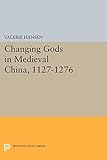Changing Gods in Medieval China, 1127-1276 / Valerie Hansen.
Material type: TextSeries: Princeton Legacy Library ; 1016Publisher: Princeton, NJ : Princeton University Press, [2014]Copyright date: ©1990Edition: Course BookDescription: 1 online resource (270 p.)Content type:
TextSeries: Princeton Legacy Library ; 1016Publisher: Princeton, NJ : Princeton University Press, [2014]Copyright date: ©1990Edition: Course BookDescription: 1 online resource (270 p.)Content type: - 9780691608631
- 9781400860432
- 299/.51/09021 23
- online - DeGruyter
- Issued also in print.
| Item type | Current library | Call number | URL | Status | Notes | Barcode | |
|---|---|---|---|---|---|---|---|
 eBook
eBook
|
Biblioteca "Angelicum" Pont. Univ. S.Tommaso d'Aquino Nuvola online | online - DeGruyter (Browse shelf(Opens below)) | Online access | Not for loan (Accesso limitato) | Accesso per gli utenti autorizzati / Access for authorized users | (dgr)9781400860432 |
Frontmatter -- CONTENTS -- ILLUSTRATIONS -- ACKNOWLEDGMENTS -- CHAPTER I. Introduction -- CHAPTER II. Lay Choices -- CHAPTER III. Understanding the Gods -- CHAPTER IV. The Granting of Titles -- CHAPTER V. Popular Deities in Huzhou -- CHAPTER VI. The Rise of Regional Cults -- CHAPTER VII. Conclusion -- Appendix I: Comparison of The Record of the Listener and a Temple Inscription Recording the Same Miracle -- Appendix II: Selected Translations from The Record of the Listener -- APPENDIX III. Tables -- GLOSSARY -- BIBLIOGRAPHY -- INDEX TO TEMPLE INSCRIPTIONS -- INDEX
restricted access online access with authorization star
http://purl.org/coar/access_right/c_16ec
In her study of medieval Chinese lay practices and beliefs, Valerie Hansen argues that social and economic developments underlay religious changes in the Southern Song. Unfamiliar with the contents of Buddhist and Daoist texts, the common people hired the practitioner or prayed to the god they thought could cure the ill or bring rain. As the economy rapidly developed, the gods, like the people who worshiped them, diversified: their realm of influence expanded as some gods began to deal on the national grain market and others advised their followers on business transactions. In order to trace this evolution, the author draws information from temple inscriptions, literary notes, the administrative law code, and local histories. By contrasting differing rates of religious change in the lowland and highland regions of the lower Yangzi valley, Hansen suggests that the commercial and social developments were far less uniform than previously thought. In 1100, nearly all people in South China worshiped gods who had been local residents prior to their deaths. The increasing mobility of cultivators in the lowland, rice-growing regions resulted in the adoption of gods from other places. Cults in the isolated mountain areas showed considerably less change.Originally published in 1990.The Princeton Legacy Library uses the latest print-on-demand technology to again make available previously out-of-print books from the distinguished backlist of Princeton University Press. These editions preserve the original texts of these important books while presenting them in durable paperback and hardcover editions. The goal of the Princeton Legacy Library is to vastly increase access to the rich scholarly heritage found in the thousands of books published by Princeton University Press since its founding in 1905.
Issued also in print.
Mode of access: Internet via World Wide Web.
In English.
Description based on online resource; title from PDF title page (publisher's Web site, viewed 30. Aug 2021)


